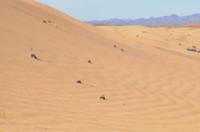Learn to describe the platypus as a bridging animal
The platypus is a very special animal, which is also known as a mosaic animal or a bridging animal. Sometimes it is also inappropriately referred to as an "ancient mammal" or a "living fossil" because there are fossil finds from the Cretaceous period that are very closely related to the modern platypus demonstrate.
The platypus, which lives in Australia, was mistaken for a fake by the researchers who first examined the remains of dead specimens. As an egg-laying mammal, it shows characteristics of both reptiles and mammals - hence the name bridging animal: It seems to build a bridge from one to the other class of animals. If you want to describe the platypus as a bridge animal, it is best to compare the characteristics of the mammal and the reptile.
Bridging animal: the platypus as a mammal
If you want to highlight the mammalian characteristics of the platypus, point out the following in particular:
- Hairiness: The platypus has a water-repellent brown fur that is reminiscent of a beaver.
- Mammary glands: After hatching, platypus cubs are fed with breast milk secreted from the females' mammary glands. Do not describe these glands as teats, because the milk leaks out of the skin and is simply licked out of the fur.
- Auditory ossicles: the hammer, anvil and stirrup are integrated in the platypus skull. Point out the fact that this is the case in all mammals - as opposed to reptiles, where the ossicles are part of the jaw.
- Body temperature of the same temperature: The platypus has a body temperature of 32 ° C. Point out that while this is a very low temperature for a mammal, unlike reptiles it does not depend on environmental factors such as the outside temperature.
In biology, bridging animals are animals in which they have characteristics of two ...
Bridging animal: the platypus as a reptile
The platypus proves to be a bridging animal to the reptile by the following characteristics, which you can point out:
- Eggs: The female platypus lays around three eggs with a large yolk and a skin reminiscent of parchment, as in reptiles, instead of a solid shell.
- Sewer: As with reptiles, the exit for the excretions is identical to the exit for the genital organs.
- Point out the most striking feature on the outside: the jaw has the shape of a beak.
- Poison glands: Male animals secrete poison through poisonous spurs - this is an ability that is common in reptiles.
In addition to the characteristics listed, there are also peculiarities in the bone structure of platypus, which are typical of reptiles and thus characterize it as a bridging animal.


